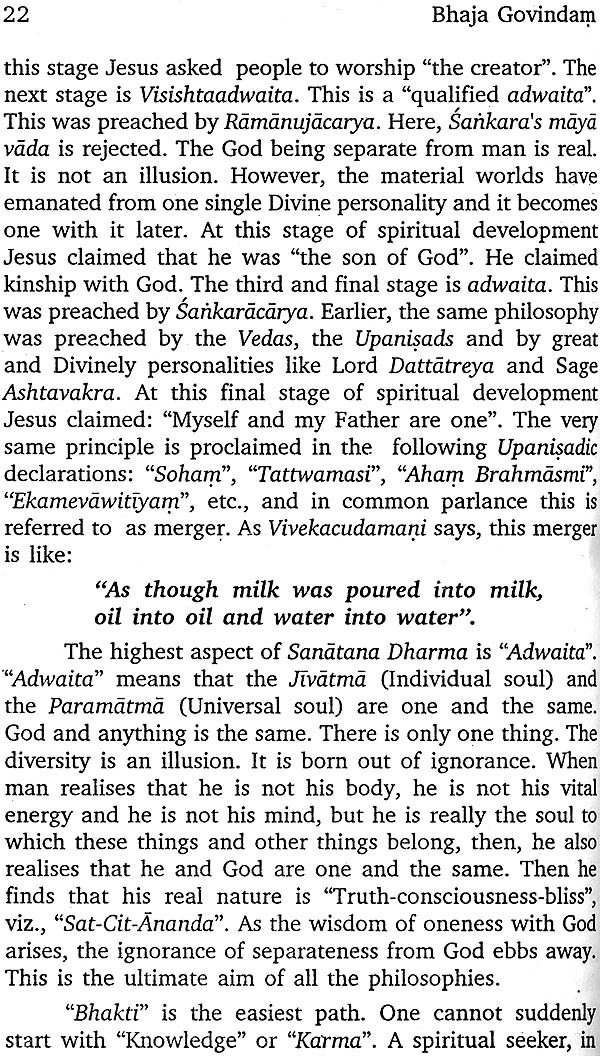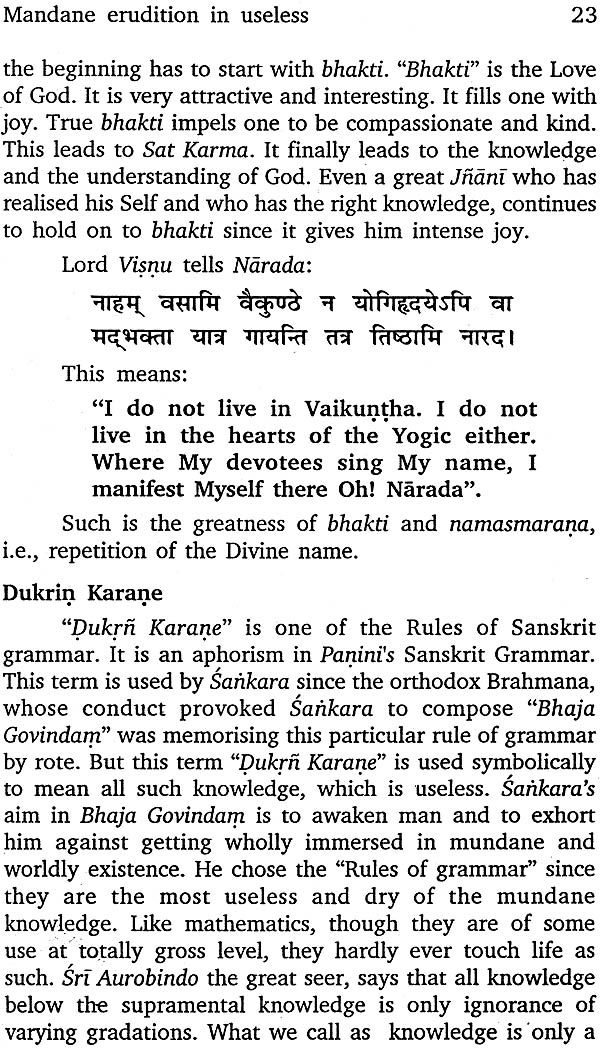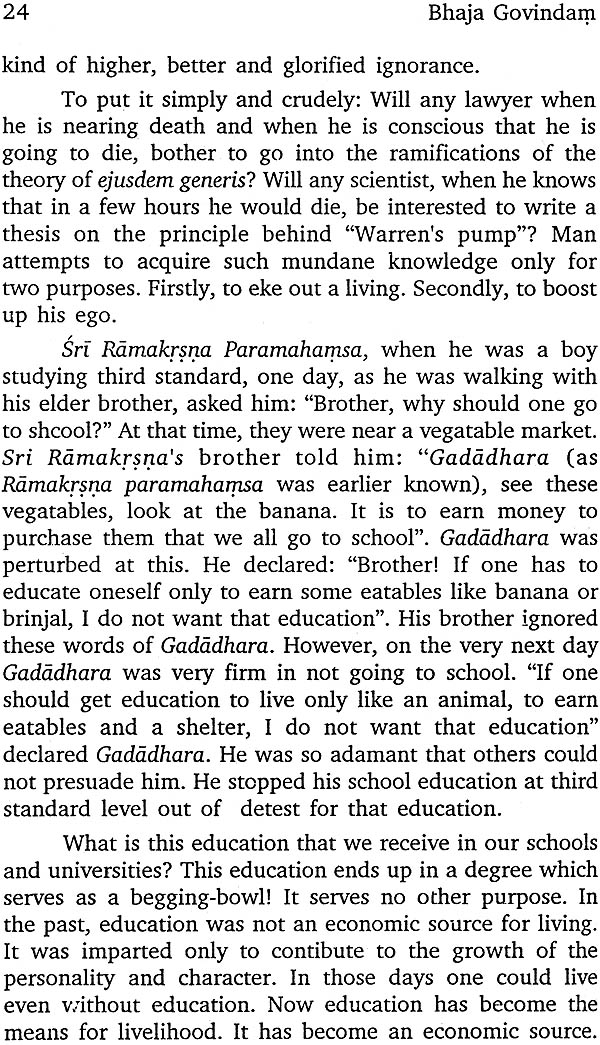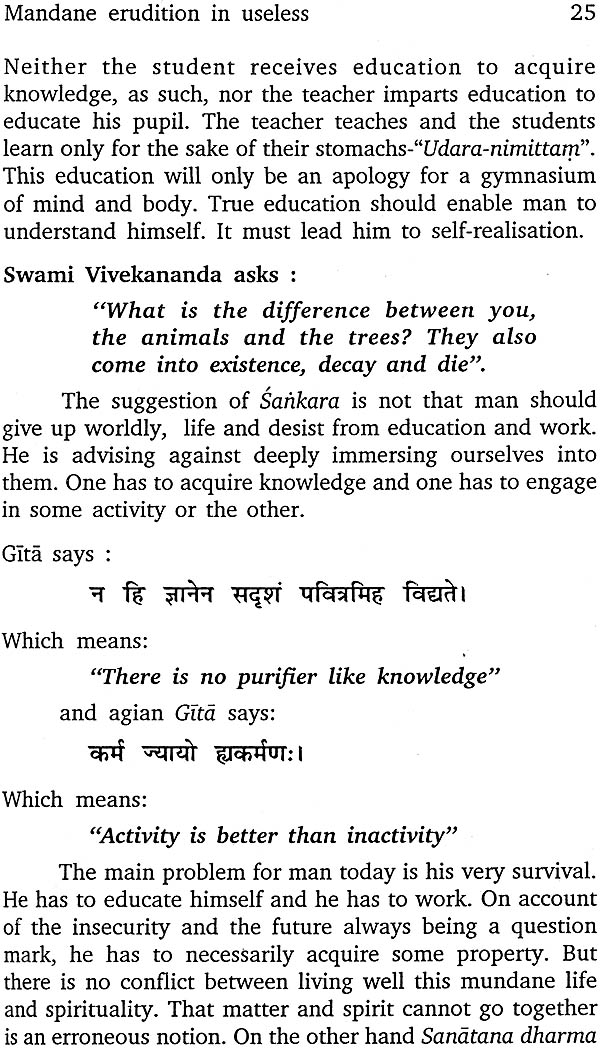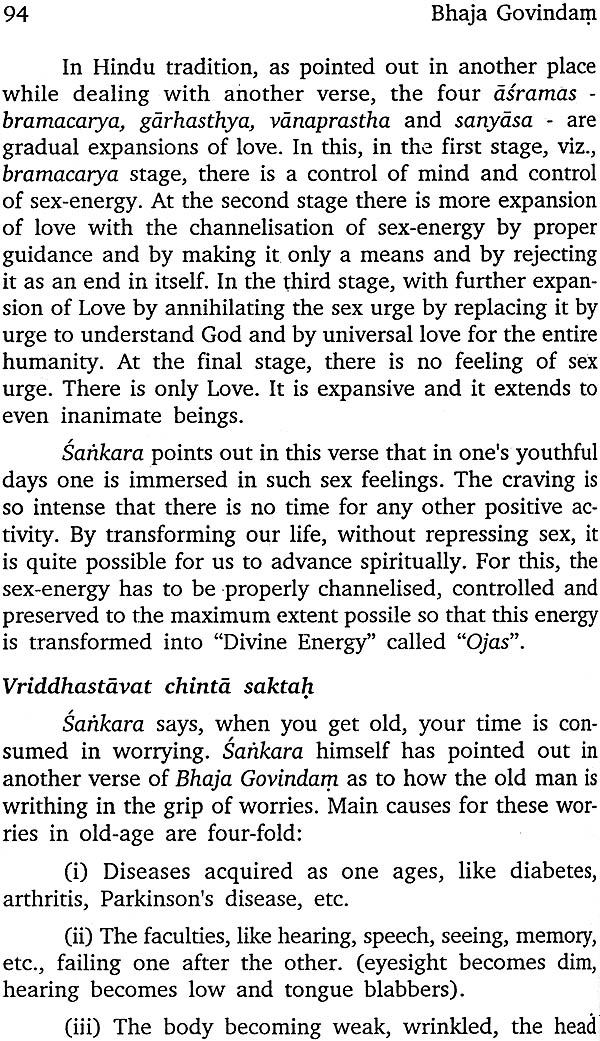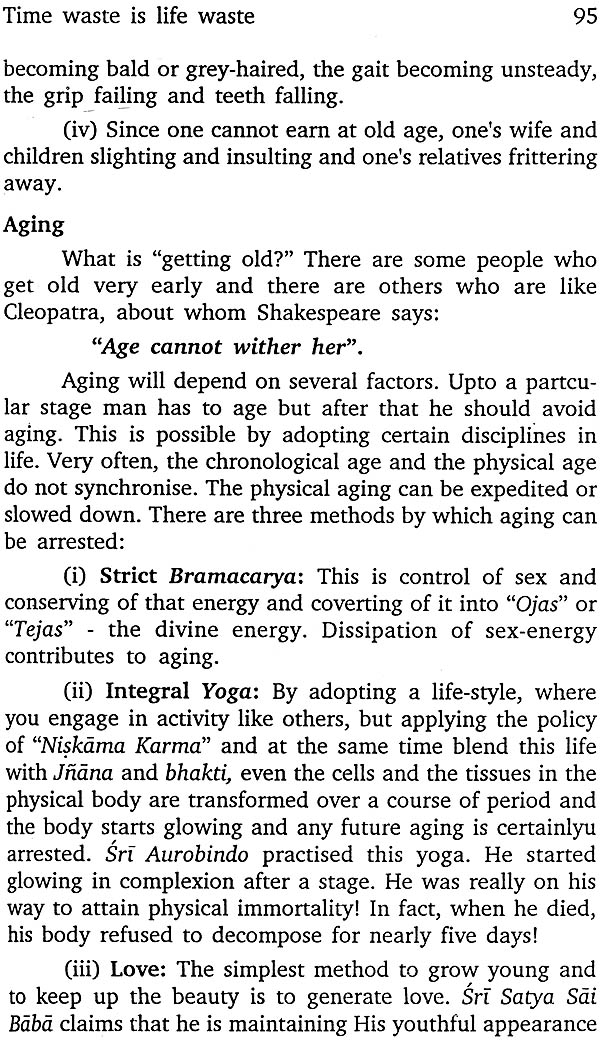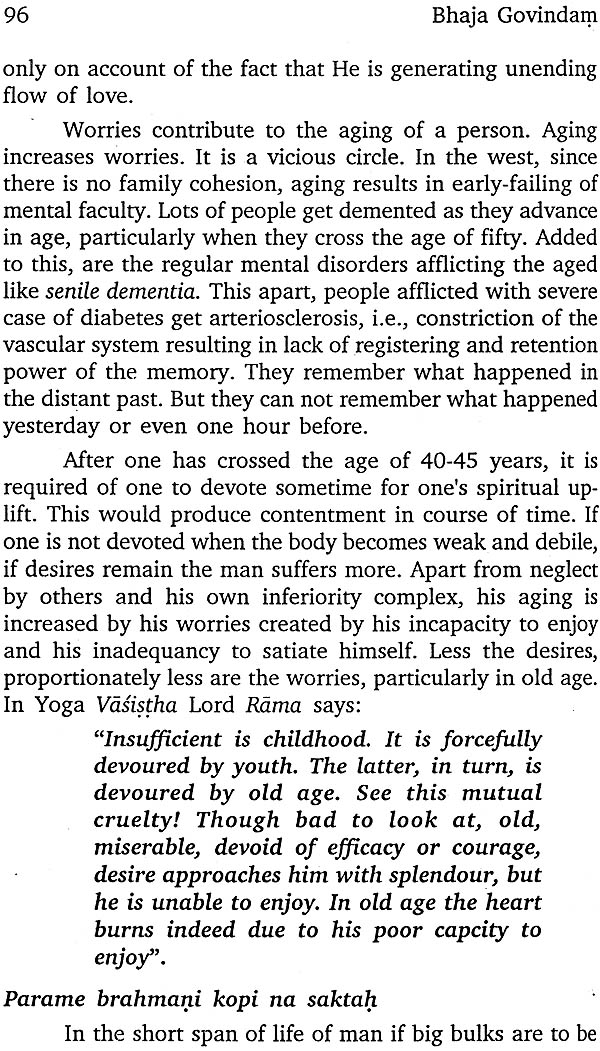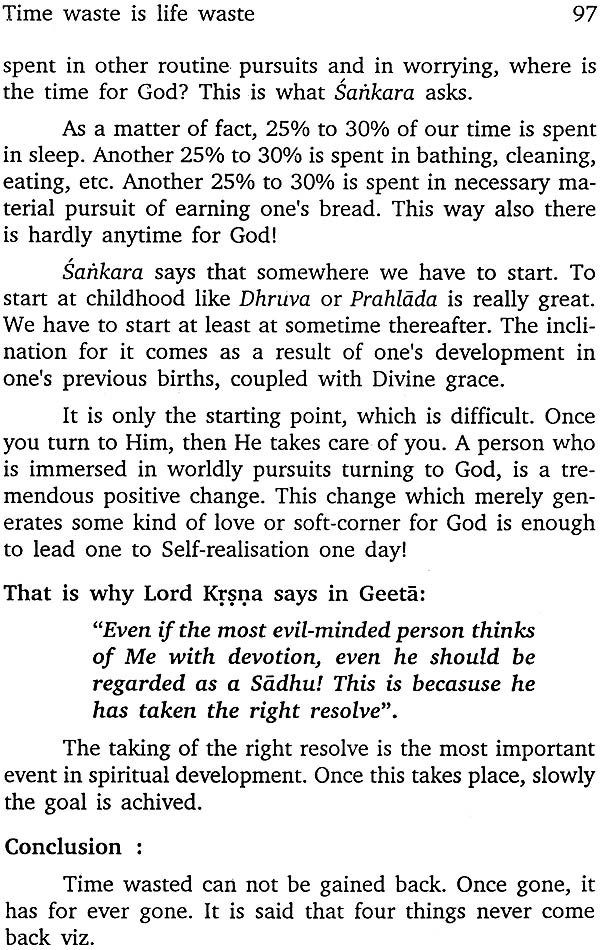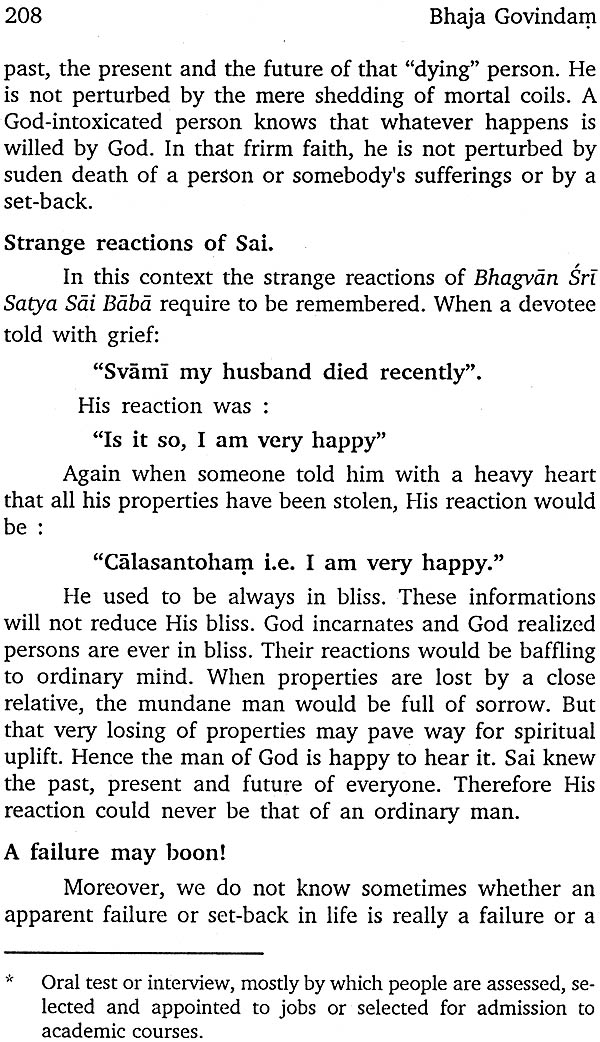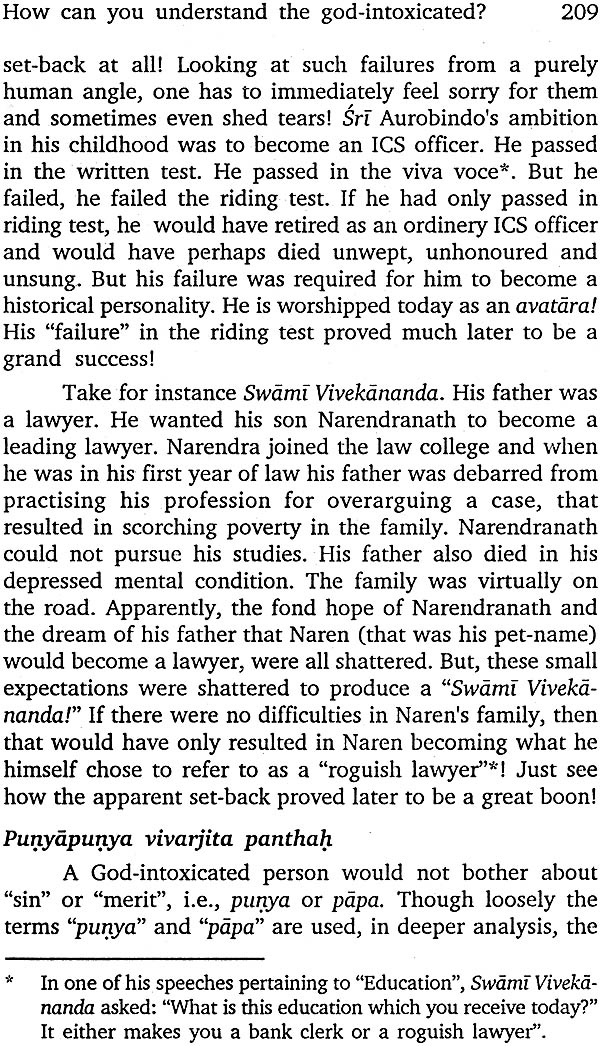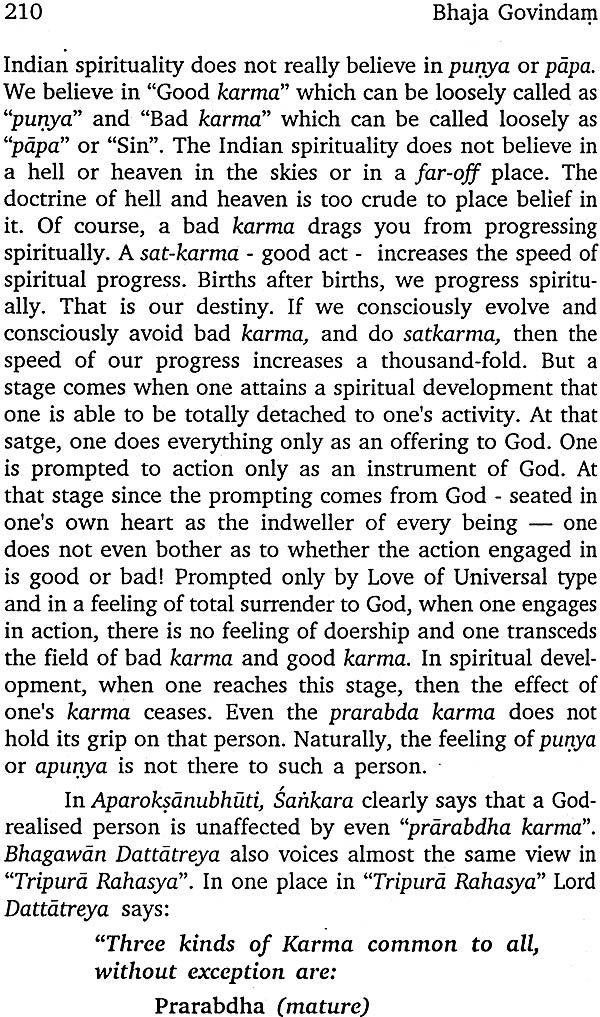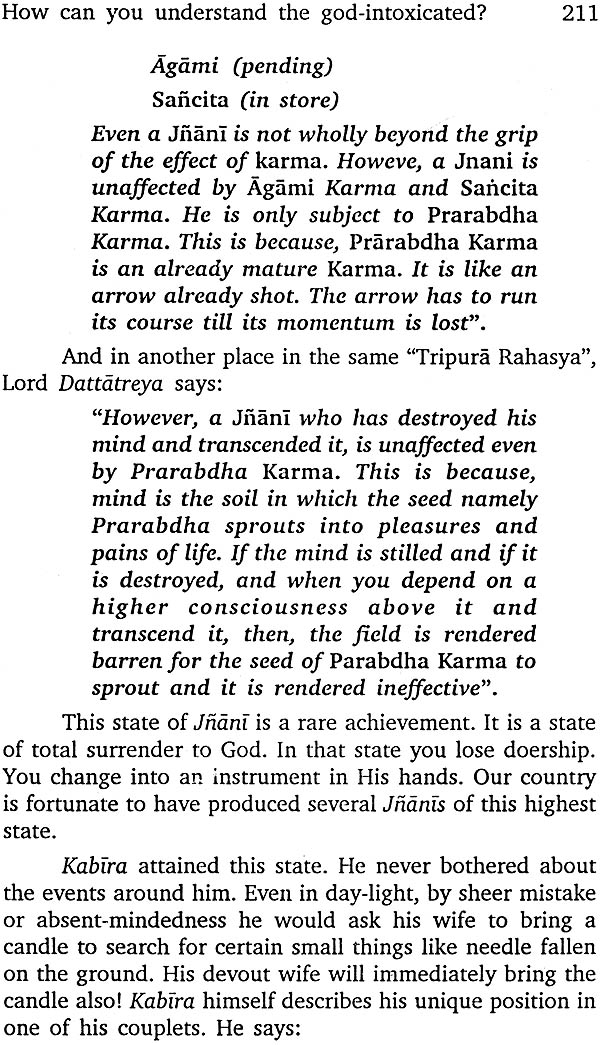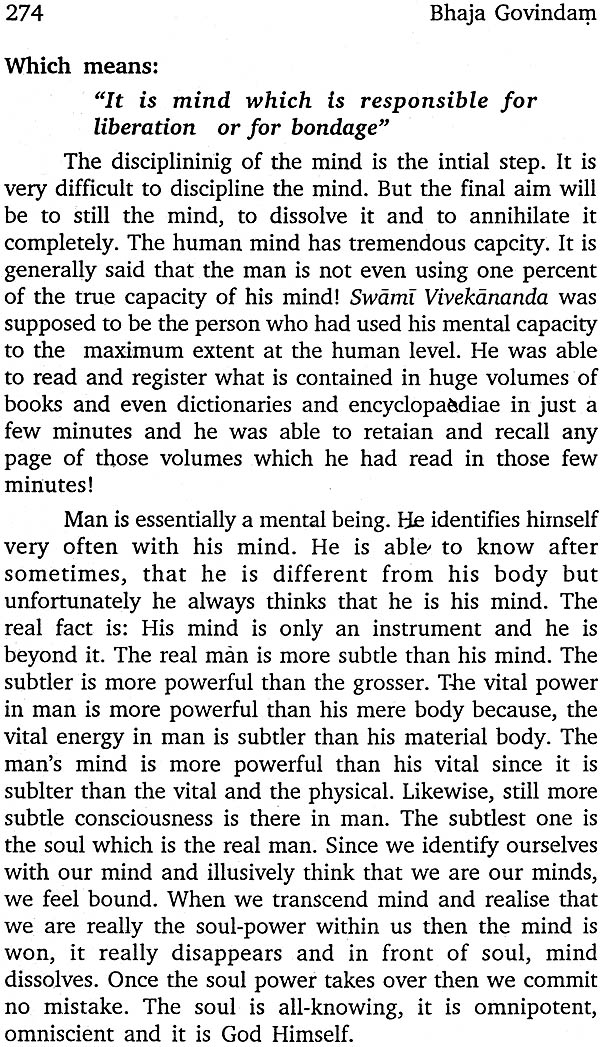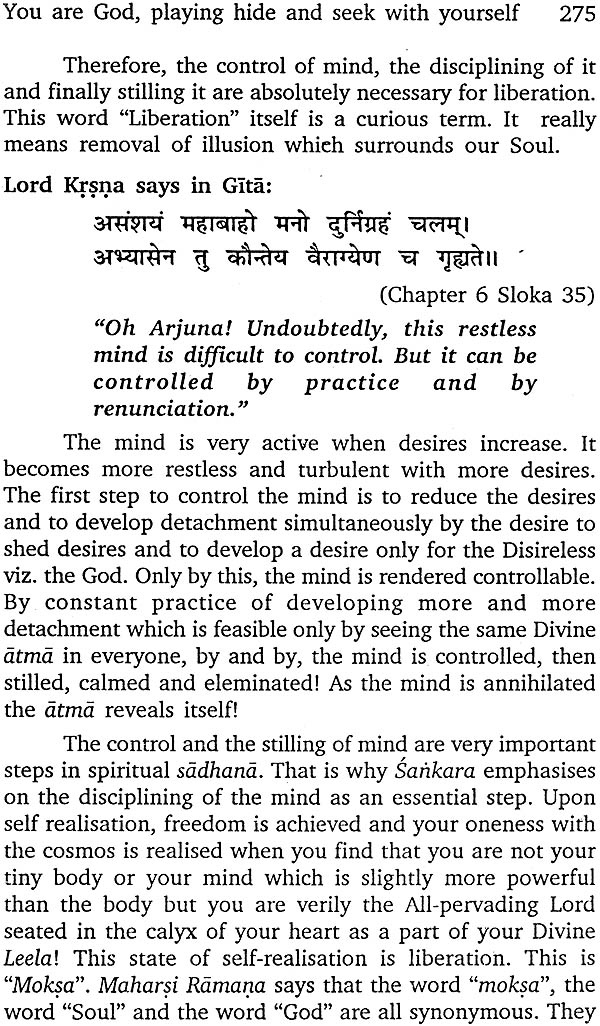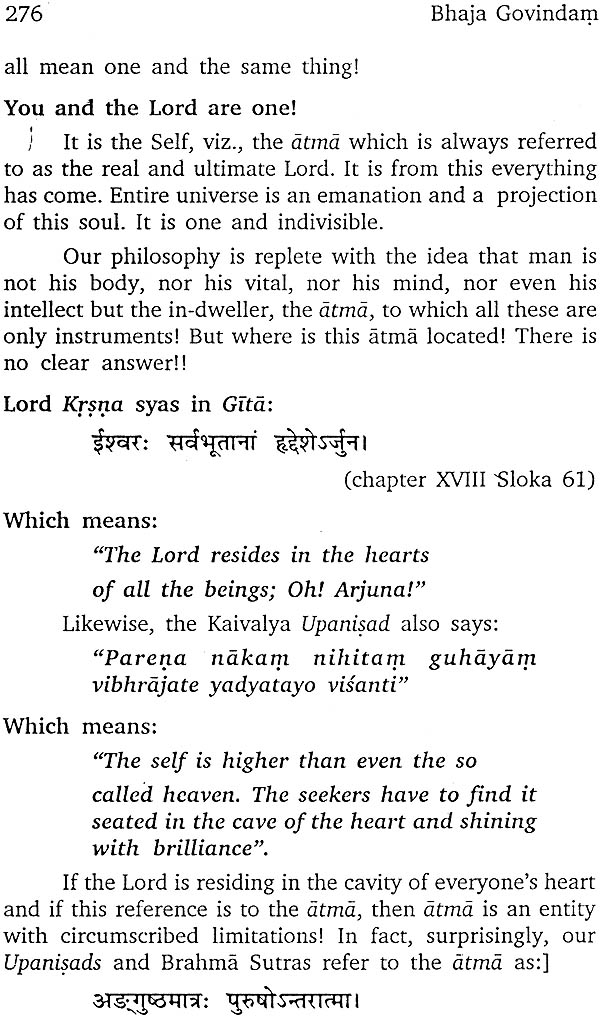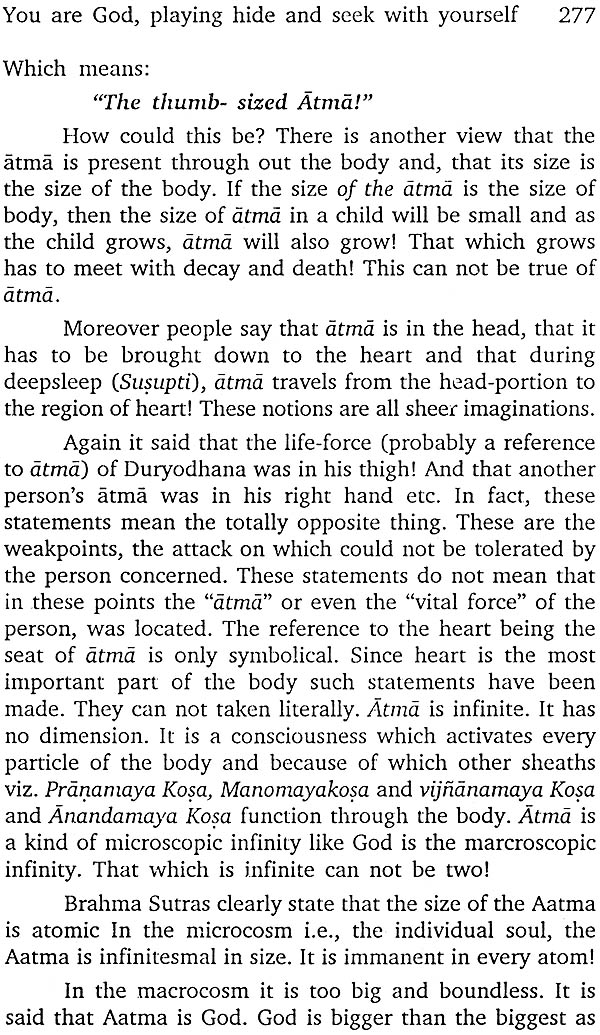
BHAJAGOVINDAM
Book Specification
| Item Code: | IDG559 |
| Author: | M.N. KRISHNAMANI |
| Publisher: | Rashtriya Sanskrit Sansthan, Janakpuri |
| Language: | English |
| Edition: | 2011 |
| ISBN: | 9789386111760 |
| Pages: | 356 |
| Cover: | Hardcover |
| Other Details | 8.8" X5.7" |
| Weight | 560 gm |
Book Description
About the Book :
There have been several commentaries on "Bhajagovindam" of Aadi Sankara. This book however is a unique one for at least three reasons: Firstly, it is the most comprehensive and elaborate commentary on the subject. Secondly, while commenting on the thirty one verses of Aadi Sankara in Bhajagovindam, the author has taken every effort to bring out the very quintessence of Indian Spirituality and has made it appeal and acceptable to a rational and inquisitive modern mind, by logical and interesting presentation. Thirdly, to drive home the point, several anecdotes and apt quotations from authoritative worked have been given in the book. If Bhagwad Geeta could be said to be the essence of the Vedas and the Upanishads the author establishes in this work that "Bhajagovindam" is the very epitomy of Bhagwad Gita itself in which the seven hundred verses of Geeta have been compressed and squeezed into just thirtyone verses without sacrificing the quality and the clarity.
Maharajapuram Natarajan Krishnamani was born on 26th April 1948. He was a product of Ramakrishna Mission Boys’ High School, Chennai. He had his collegiate education in Vaishnav College, Presidency College, and Madras Law College. He had a brief political career between 1969 and 1975. He was also a Trade Union leader at that time. In 1975, under the influence of Sri Navajata of Sri Aurobindo Ashram, Pondichery he left politics and plunged into spirituality. Enrolled as Lawyer in 1971, he had active practice in the Madras High Court upto 1981. He was a junior of the world renowned Constitutionalist Sri M.K. Nambiar and the famous Supreme He was a junior of the world renowned Constitutionalist Sri M.K. Nambiar and the famous Supreme Court Senior Advocate Sri K.K. Venugopal. He shifted his practice to the Supreme Court in 1981. When he was a young lawyer of 43 years, he was designated as Senior Advocate.
Sri Krishnamani is a prolific writer. His erudite articles have appeared in leading Dailies and in leading Journals on spirituality and current Affairs. Two of his books: “Bhaja Govindam” and “Godlymen & Their Golden Words” (Two Volumes) were published by Rashtriya Sanskrit Sansthan. His other books include : “Sankara, the Revolutionary”, “Sai on Himself”, “Sankara, Adwaita and Kancimaha”. “Premopanisad ” (Ten Volumes), “Divine Incarnation, a Mystery”, and “From Doubt to Certainty”,
Sri Krishnamani was the President of the Supreme Court Bar Association, which is a prestigious position, several times, He was the President of Delhi tamil Sangam. He received the National Law Day Award for Excellence in Civil Law in 1998. He was given Paramacarya’s Seva-Ratna Award in 2005. He received “Communal Harmony Award” in the year 2005. He was the President of the Delhi Tamil Education Association running seven schools in the capital and he is associated with several other educational and social welfare organizations including. Banyan Tree School, Lady Irwin Schools, Veda Parishad, Society for Communal Harmony. Sanatan Sangeet Sanskriti, Bharat Heritage Foundation, and International Sathya Sai Centre. He was a Visiting Faculty in the School of Planning and Architecture (a Deemed university) taking classes for Post Graduate students in Building laws, He is the Chairman, All India Senior Advocates Forum – a unit of the Bar Association of India, He was in the Governing Council of National Law School at Bangalore, At present he is a Member of the Governing Council of National Law School University, Bhopal.
“Bhaja Govidam” of Sankara consists of thirty one slokas. Originally they were together known as : “Mohamudgaram” i.e., “Dispeller of delusion”. Because of the popularity attained by the first line, these 31 verses, came to be commonly referred to as “Bhaja Govidam”. The literal meaning of this term “Bhaja Govindam” is : “Worship Lord Krsna and utter His Name.”
In these slokas, which are really addressed to the entire humanity, it is emphasized that man should repeat the name of God and thereby conquer his four inner enemies: Greed, Lust, Anger and Delusion, so that he can evolve into a higher Being.
He preached Adwaita philosophy. But at the same time, he believed in Bhakti. His hymns: Soundarya Lahari, Sivananda Lahari, Hari-Sankara Stotra, Jagannatha Asaka and this work “Bhaja Govidam”, not only emphasize on Bhakti but brim with poetic beauty. Sankara lived only for 32 years. He was the first one to consider the entire Bharat as his field of activity. His missionary zeal was incomparable. In that hoary past, Sankara traveled all over this country three times, on foot! Sankara’s Guru Govindapada was a Kashmiri, his Guru Goudapada was a Bengali and Goudapada’s Guru, Patanjali was a Tamilian! These facts show that thought there were hundreds of kings and mini-kings ruling over different kingdoms, spiritually and culturally India was always one!
The ideas in “Bhaja Govindam” are relevant even today. There are several books on this work of Sankara. But, this one is unique and perhaps the largest commentary on the subject. This is the third and revised edition of Bhaja Govindam. As predicted and expected by the renowned Jurist, Sri. N.A. Palkhiwala, this book is one of the popular products of Rahstriya Sanskrit Sansthan.
We are happy to bring out the second edition and fourth reprint of Bhaja Govindam authored by Shri M.N. Krishnamani. Shri Krishnamani is not only a legal luminary and one of the leading practitioners of law in the country; he has made original contributions to the study of Sanskrit literature by his writings. Rashtriya Sanskrit Sansthan has earlier published another work by this scholar entitled ‘Godly Man And Their Golden Words’ in the series of its Golden Jubilee Publications. Through these publications, Shri M.N. Krishnamani has established his credentials as an academician with a genuine interest in ancient wisdom.
Bhaja Govindam by Shri Krishnamani is indeed a land mark in the history of study of stotra literature of Sanskrit. With remarkable insight, Shri Krishnamani here presents authentic interpretation of each and every line of this stotra. His expositions lead us to a journey in the spiritual world.
Bhaja Govindam by Sri Adi Sankaracarya is a unique poem. As an intellectual and a great philosopher, Sri Sankaracarya revolutionized the whole scenario of philosophical discourse and world view. As a poet, his writings present rare synthesis of philosophy and aesthetic vision. He has introduced entirely a new genre through Bhaja Govindam and also a new metre pajjhatika in Sanskrit poetry. This small poem also presents a meeting ground of classical Sanskrit and new Indo-Aryan languages and transition into new idioms of poetic expression. Sankaracarya here presents the empirical, psychic and the metaphysical worlds together. Each stanza in Bhaja Govindam assumes epic proportions. Shri Krishnamani has done a life long research works on this stotra and unearthed heitherto unknown aspects.
Sri Sankaracarya was not only a philosopher and a great poet gifted with a vision in intuition, he was a great organizer also. The circale of disciples like Suresvara, padamapada and others accompanied him during his digvijaya. They formed an academy of letters. Therefore Shri Krishnamani has rightly discussed the contribution of these disciples in the composition of the stotra ‘Bhaja Govindam’.
I am confident that this revised new edition of Bhaja Govindam will be received with appreciation by scholars and lovers of Sanskrit world.
Shri Krishnamani, a Senior Advocate of Delhi has taken time off his busy professional preoccupation to write on this celestial confluence of Bhakti and Jnana. I feel privileged to inscribe this forewords to this works of devotion.
The lore has it that this beautiful Hymn to Govinda is Adi Sankara’s compassionate upadesa to a scholar at Varanasi who was wasting his time on the subtleties of Sanskrit grammar to turn him towards God. Adi Sankara is said to have composed on the spot, twelve verses, the “Caturdasa Manjari Stotra”. Some editions set them separately. There are also some differences in speculation as to the order in which the verses occur. The “works of Sankaracarya” (Sri Vani vilas Press) sets out thirty one verses of this Hymn.
The second verse refers to the imperative of “Vitrsnam” the de-thirsting of worldly desires. Indeed Patanjali defines “Vairagya” as “Drstanusravika-visaya-vitrsnasya Vasikara samjna vairagyam” (Yoga-Sutra: Sadhana Pada 15)
Adwaita explains the prevailingly absolutistic standpoint of upanisidic teaching by postulating one reality and the rest of the universe as its appearance. The classic of Adwaita epistemology “Vedanta Paribhasa” of Dharmaraja Adhavarin refers to how the one non-dual consciousness appears split ino Cogniser, Cognition and the Object. Empirically this is not possible to be explained. To say that this is the work of Maya is only to recognise it as inexplicable. The purpose of valid knowledge is therefore not to attempt to solve this insoluble issue of man’s spiritual quest, but to go beyond it. The profound epistemological truths are the three upanisidic concepts of the ‘Brahman’; that metaphysically ‘He’ is the central principle of all, ethically, ‘He’ orders everything and theistically “He” is the goal of all philosophical quest. The Svetaswatara posits these questions: What is the source of this Universe? Whence are we born and by what we are sustained? What is our ultimate goal? Who guides our experience of joy and sorrow? and answers them; to say that the seers intuited that the source of all this is ‘Devatmasakti’ It is outside the reach of the conscious working of the mind and outside the perceptive senses. It is supra-rational and perceived only by higher levels of consciousness.
“Bhaja Govindam” stresses that pursuit of wealth for its own sake is a deadly illness and that equally deluding is that entrapment of lust. The last verse speaks of the liberating force of devotion to the lotus feet of the Guru.
Shri Krishnamani has secured for the reader this purificatory grace of the Guru by his commendable elaboration of the auspicious theme of Bhaja Govindam and earnt their gratitude. He has endeavoured to unfold, the great beauty of the Indian philosophical traditions and the interesting dimensions of their curiosities. He has indicated that if knowledge should shape itself into values, it needs to be turned into action.
Bhaja Govindam was composed by Adi Sankara when he was amused to find an old Pandit taking pains to memorise by rote a particular ‘Rule of Grammar’ in Sanskrit called ‘Dukrn Karane’. This incident happened in Varanasi (Benaras) when Sankara was on yatra with his disciples in Eastern UP in North India. When he saw that Pandit memorising the Rules of Grammar by rote, Sankara advised him on the spot that the Rules of Grammar would get him nothing at that old age and that instead of wasting his time in such pursuits; the old man should devote his time in spirituality since already he had wasted a bulk of his life-time. This was the motivation for Sankara to come out with a garland of thirtyone flowers known together as “Bhaja Govindam”. In this context, it is interesting to remember that Sankara’s Guru Govindapada came to Gaudapada only to learn Sanskrit Grammar. Sankara’s Guru’s Guru Gaudapada was a student of Patanjali who was a Sanskrit grammarian. He was also the author of the famous ‘Yoga Sutra’. It is ironical that Sankara is ridiculing the study of grammar and the over-importance given to it by the old man in Bhaja Govindam, when his Guru, his Guru’s Guru and his Guru’s Guru’s Guru were all great grammarians! A careful analysis of all the thirtyone slokas would show that Sankara has referred to “grammar” only as a symbolism. By “grammar” he means all mundane pursuits for one’s sheer material living.
How they became thirtyone?
After the above incident, coming back to his camp with his disciples, Sankara ruminated over this amusing event. Sankara, a lad of just thirteen years felt that like this old Pandita, the entire humanity was steeped in mundane pursuits hampering its further evolution to become Divine. The too much of animalistic existence of man throughout his life irked Sankara. Sankara does not say in these verses that everyone should become a monk even in childhood. He felt that man being too much involved and engrossed in, and too much worried about his material pursuits would ruin himself and take himself away from his real goal.
Sankara felt so, out of compassion to the entire humanity. This prompted him to initially compose twelve slokas advising the entire humanity as to how human life is a precious opportunity and how the short life-span of man cannot be allowed to be wasted in routine animal ans sub-human activity. The telve verses initially composed by Sankara were together known as “Dwadasamanjari”. Thereafter his principal disciples numbering fourteen composed one sloka each. The total with these fourteen came to twentysix slokas. It will be difficult to find any difference between the slokas composed by Sankara’s sisyas were of equal excellence. One has to remember that these sisyas have composed their fourteen slokas based on Sankara’s teachings only and by drawing inspiration from Sankara himself.
After hearing his disciples fourteen slokas, Sankara was immensely pleased with their marvellous capacity in imbibing his views and in expressing those views in simple but rhythmical Sanskrit poetry. In that pleasant mood and in that ecstasy, Sankara composed five more slokas and then brought the total of thirtyone! All these thirtyone slokas were originally given the name “Mohamudgaram” by Sankara. “Mohamudgaram” in Sanskrit means the “dispeller of delusion”. Later, in view of the fame acquired by the opening verse, which starts with the words “Bhaja Govindam”, these thirtyone verses came to be referred to as “Bhaja Govindam”. Though fourteen of these slokas were actually composed by his sisyas, they are very much Sankara’s oritinal views. However, of these sisyas, who composed the fourteen slokas and which sisya composed which particular slokas are also essentially Sankara’s views, all the thirtyone slokas are broadly referred to in this book, as the work of Sankara.
| Blessings : Swami, Paramanda Bharati, Sringeri Shankaracharya Mutt, Sringeri
| ||||
| Preface : Hon'ble Mr. Justice M.N. Venkatachaliah (former Chief Justice of India)
| vii | |||
| Acknowledgement | ix | |||
| Instructions to read the book | xi | |||
| Introduction | 1 | |||
| How they become thirtyone? An Adwaitin preaching bhakti No conflict between the three philosophies . Sankara - was he a Saivite? . avatara and Vibhuti. Significance of Sankara's advent. The central theme of Bhajagovindam.Guru bhakti of Shankara . How bhakti leads to self-realisation? | ||||
| 1. | Mundane erudition is useless | 19 | ||
| Emphasis on Bhakti Yoga. Dukrin Karane . Do we prepare for our death? . How do we pre-fare for our death? "Modda Mate" - Oh! Fool! | ||||
| 2. | Faith in karmka alone gains contentment | 33 | ||
| How to develop contentment? . Sufferings and karma doctrine . Who is suffering for the past karma . Contentment could be developed only by implicit trust in karma doctrine | ||||
| 3. | Sex craving - nip it in bud | 43 | ||
| 4. | Life is ephemeral | 51 | ||
| Viddhi vyadhi abhimana grastam . Lokam soka hatam cha samastam | ||||
| 5. | Your relatives? Aye! Your money's relatives! | 59 | ||
| 6. | Body vacated by life-force: even wife is afraid of | 65 | ||
| Why bhaarya bibhyati? . Worse than a pair of slippers! | ||||
| 7. | Oh! Richman! Beware! Even of your son! | 73 | ||
| How wealth could be dangerous? . The craving to accumulate wealth demoralizes man . Putraadapi dhananbhaajam bitihih . Sarvartaisha vihita ritihi | ||||
| 8. | Time waste is life waste | 85 | ||
| Balastavat Kreeda saktah . Tarunastava taruni saktah . Vriddhastavat chinta saktah Aging Parame brahmani kopu na saktah | ||||
| 9. | Strange indeed, is this cycle of life | 101 | ||
| ka te kanta kaste puthrah. Oh! My brother. How other address the humanity? . This samsaara is very strange . Kuta Aayatah: where from you have come? | ||||
| 10. | Satsanagh leads to liberation | 111 | ||
| Significance of Satsangh . What is "Satsangh"? . How Satsangh results in detachment? . How by detachment, delusion is overcome? > Jeevan Mukti | ||||
| 11. | Right knowledge is the way to immortality | 123 | ||
| Vayasi gate kaha kaama vikaarah . Sushke Neere kaha kaasarah . ksheene vitte kaha parvarah . jnaate tatwe kaha samsaarah . Corssing the ocean of samsaara - What this means? | ||||
| 12. | Destroy pride, else it will destroy you | 131 | ||
| How to overcome maaya? . Brahmapadam twam pravisa viditwa | ||||
| 13. | Time passes with ticks of clock, but grips of desire leave you not | 139 | ||
| 14. | Of what avail is the shaving of the scalp? | 145 | ||
| Do we deteriorate? . Vesha sanyaasis | ||||
| 15. | Oh! Wrinkled and bald man, old! Why not you free from desires' hold? | 151 | ||
| The obstructive role of desire in spirituality . Desire is the cause for rebirth . How to achieve this desirelessness? . Old and desire | ||||
| 16. | Desire is a challenge, even to a sanyaasi | 159 | ||
| The basic desires of man are five-fold | ||||
| 17. | Go beyond rituals | 163 | ||
| 18. | You want bliss? Then renounce | 173 | ||
| 19. | Fix your mind on God; bliss you get unsought | 179 | ||
| yogaratova bhogaratova . Sangaratova sangavihinah . Nandati nandati nandatyeva | ||||
| 20. | It is the right resolve which matters | 185 | ||
| Does not the idea in this Verse conflict with other verses? . Yamena na Charcha | ||||
| 21. | Seek the company of the holy. It is not too late | 193 | ||
| Oh! Vaatula . Sankara ridicules the worldly old man . Satsangh is the only way | ||||
| 22. | Cycle of births-and -deaths: end it, Oh! Krishan! | 199 | ||
| Cycle of births-and-deaths . Punarapi janani jathare sayanam It is difficult to overcome this samsaara | ||||
| 23. | How can you understand the God-intoxicated? | 207 | ||
| Punyaapunya vivarjita panthah . Like a child or a mad man . God Himself is referred to as a mad person . He is indeed in immense bliss | ||||
| 24. | This world is but a dream | 217 | ||
| 25. | Achieve non-duality by seeing God in everyone | 221 | ||
| Vaasudeva experience of Sri Aurobindo . Story of Ramanuja's Sishya . Self-realisation is the cul-mination of pure Bhakti | ||||
| 26. | Equanimity leads to Divinity | 229 | ||
| Vishnutwam . Equanimity . Why should we avoid affinity too? . Love of God leads to love of everything else | ||||
| 27. | Self-knowledge dispels superstitions | 235 | ||
| Leaving krodha, kama, lobha and moha am I? | ||||
| 28. | Three-in-one path speeding up spirituality - satnam, satsangh and seva | 243 | ||
| Major Geetas . Minor Geetas . Vishnu-sahasranaama . Satsangh is to be sought after . Wealth has to be spent on poor people | ||||
| 29. | What a pity? Knowingly you fall into a ditch! | 257 | ||
| Why Sankara advises from man's angale? . Excessive sex enjoyment results in discases | ||||
| 30. | Stilling and killing of mind - the way to God | 263 | ||
| Praanaayaama . pratyaahaara . Viveka vichaaram . Japa! . Samaadhi | ||||
| 31. | You are God, playing hide and seek with yourself | 271 | ||
| Concept of "Guru" . Necessity of a "Guru" . Guru is regarded as God Himself . Disciplining of mind . Lord is the indweller of your heart | ||||
| Epilogue | 281 | |||
| Glossary | 289 | |||
| Bibliography | 313 | |||
| General Index | 319 | |||
| Index to Slokas | 327 | |||
